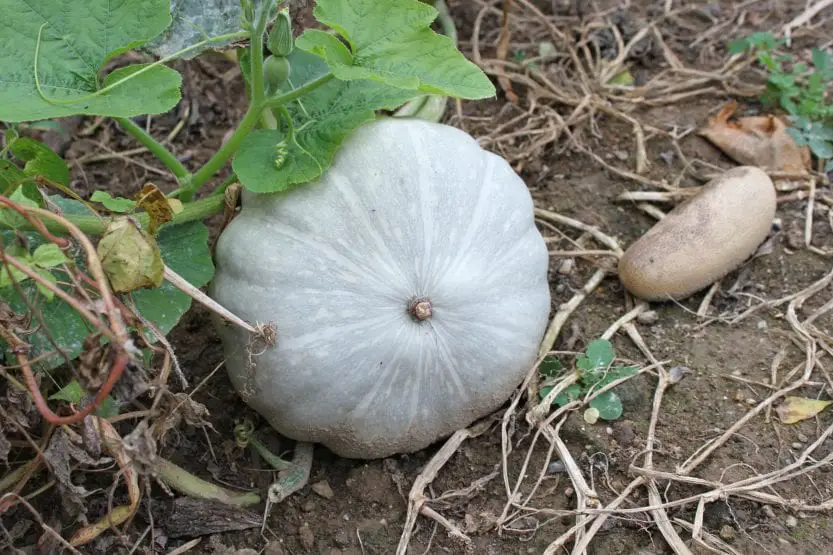Blue pumpkins are a seasonal fruit usually available in the fall, botanically classified as the ‘Cucurbita Maxima’. This seasonal fruit size varies from around 15 cm to 25 cm in diameter and has a weight differing from 6 to 10 pounds, as per the size. This round to oblate shaped fruit with a flattened blossom & a unique stem end has a deeply-ribbed firm exterior. It comes in a range of colors from dark green to a dusty blue-green with a light brown, rough stem. The interior of the blue pumpkins has a dense deep orange thick flesh with a cavity in the center full of pulp & uniformly shaped cream-colored seeds. The sweet flesh of the blue pumpkins is mildly fruity & aromatic in nature and attains a smooth string-less dry texture on cooking.
Facts & Varieties:
Blue pumpkins, botanically named as Cucurbita maxima belong to the Cucurbitaceae family also known for its gourds and squash, other than pumpkins. Blue pumpkins or things that are blue, annually grow on long sprawling vines which sometimes grow up to nine meters in length.
There are various kinds of Blue pumpkins such as:
- Queensland Blue
- Australian Blue
- Jarrahdale
- Blue Doll
- Blue Moon
- Blue Lakota.
Extremely popular in Australia & New Zealand, these, blue pumpkins, things that are blue, are hugely favored as a cooking pumpkin due to its thick flesh, string-less texture & super taste. The unusual dusty blue-green rind exterior contrasting with the bright orange inside the Blue pumpkins makes it more favored, when compared to other pumpkins.
Blue pumpkins, things that are blue, have good nutritional value as it contains high fiber content, beta-carotene, along with vitamins A and C, and potassium.
Cooking with the Blue Pumpkins:
Blue pumpkins can be cooked through boiling, baking, steaming, or even roasting depending on the food preparation. Both sweet & savory preparations can be prepared with the Blue pumpkins but the sweet flavor of its flesh makes it more favorable for sweet preparations such as deserts & baked delicacies. The sweet string-less structure of the Blue pumpkin’s flesh is very much favored to blend in various dishes. Soups, stews, or even curries are blended with cooked Blue pumpkins or even sometimes added into risotto, gnocchi, ravioli, salads, and pasta dishes, in giving more body and flavor.
Other than the flesh, Blue pumpkin seed also is a very tasty snack when cleaned & roasted. Blue pumpkins combine well with garlic, onion, tomatoes, rosemary, parmesan cheese, and dried cranberries, etc., in cooking delicacies. They also go very well with meat items such as turkey, poultry products, and sausages in cooking exotic meaty dishes. Blue pumpkins, things that are blue, can be preserved for 3-6 months if stored in a cool & dry place.
Ethnic Origin:
The majority of the Blue pumpkin fruit in Australia is produced by Queensland & New South Wales. They also have been pioneers in developing new varieties of the fruit in creating wider choices. Afresh interest in celebrating Halloween in Australia has also increased Blue pumpkins sales considerably. The sale of ingrown pumpkins in Australia has gone up also due to the new popular notional decoration style of using pumpkin & pumpkin carvings in front of the house.
History:
Blue pumpkins, things that are blue, were originally grown in Central & South America and migrated to various countries across the world through expeditions & traders. Its introduction period to Australia is unknown but as of today, the Australian variety & range of pumpkins are the most famous in the world. The well-known and famous Queensland Blue pumpkin was introduced to the United States in the year 1932. Blue pumpkins, things that are blue, are easily available at the local farmer’s market & at specialty grocery stores all-over in Australia, New Zealand & in the United States.
Describing A Pumpkin:
There are specific terms used while describing a pumpkin. Pumpkin terms:
- SKIN: The exterior part or the colored outside part of the pumpkin.
- FLESH: The inside material used for cooking purposes other than the seeds.
- CARVABILITY: The ease of digging into the skin & flesh for carving purpose.
- SHAPE: Pumpkins are never round in shape. They are round to oblate shaped fruit with a flattened blossom other than being uneven.
- TEXTURE: Pumpkin texture can be known by feeling the skin of the pumpkin. They could be slightly rough or brushy, uneven, or with a soft & smooth texture.
- RIBBING: The vertical stripes are quite a common feature of the pumpkin, unlike any other fruits or vegetables.
- SIZE: They are available in various sizes ranging from small to medium to big & sometimes indicated also in weight depending on the pumpkin.
- SHELF LIFE: Shelf life means whether it will remain preserved, if uncut, for a certain period of time or will it perish immediately, if withered of the vine.
Various Types of Blue Pumpkins:
The blue pumpkins, things that are blue, have dubious ghostly appearance in comparison to the other warm orange-yellow colored pumpkins. The best Blue pumpkins are:
- Blue Lakota: A variety of pumpkins from the Midwest. The exterior of the Blue Lakota has a color with a hint of blue & green, slightly ribbed & is oblate shaped.
- Kabocha: It is a pumpkin similar to the green pumpkin. Popular in Japan & also known as Japanese Pumpkin, Ebisu, Delica, Hoka, and Hokkaido Pumpkin. It has a tough & green skin texture with a firm yellow flesh which retains its shape even after cooking. It is unassumingly round & has a sweet flavored flesh when cooked, making it a favorite choice in the kitchen.
- Kakai: This pumpkin is produced in Japan. Kakai pumpkins usually weigh around 5 to 8 pounds, has a grey skin with orange stripes. This pumpkin is not a popular choice for its flesh but for its blue seeds, which is immensely tasty when roasted.
- Jarrahdale: This pumpkin, a cross between the Cinderella pumpkin & the Blue Hubbard pumpkin, is an Australian heirloom pumpkin, developed indigenously. It is a flat but a rounded shaped pumpkin with light blue-grey skin & a deeply ribbed exterior. The golden yellow flesh in the interior of the Jarrahdale pumpkins are the finest to make pumpkin pies, some experts feel. The flavor of the flesh is mildly sweet with a creamy & dense texture.
- Blue Max: Description quite similar to Jarrahdale pumpkin except for the skin color which is pale blue.
- Queensland Blue: A medium-sized pumpkin with a flattened blossom & stem ends. It has a yellow-orange flesh in the interior with a deeply ribbed & hard grey skin on the exterior.
- Australian Blue: The Australian blue is a bluish-grey squash that looks quite similar to a blue pumpkin. This bluish-grey squash often referred to as a pumpkin has a thick orange flesh which is soft & mild in taste, like a pumpkin. It can be used for baking in making pies & cakes or even soups too, other than roasting it.
Blue Pumpkin & Autism:
Halloween time is the time for children to dress up as something scary to play the custom of trick or treating. But instead of the colorful deep orange pumpkin signifying Halloween, if someone comes to your doorsteps with a blue pumpkin, would you be able to guess its meaning?
Lately, awareness about autism has been very prominent by turning the Halloween pumpkins blue or having blue plastic pumpkin containers. This idea is to signify that the person trick or treating with a blue pumpkin is an ultra-sensitive person with specific needs.
Socially interacting or communicating is quite problematic for people with autism and that’s why Halloween should be played in a different way especially for them.
- Trick or treating by the day instead of the night as the dark might trigger anxiety in autistic people.
- Keep the trick or treating limited to certain houses where they already know of the visit & planned accordingly.
- Let the child select his passionate costume even if it does not fit into the scary theme. Involve the child during the planning to make him comfortable.
- An autistic child is ultra-sensitive & can become distressed with indifferent attitude & stares from strangers or the public. It is the community or the public who has to take a more positive approach in making it easier for people with autism. Halloween is one of them.
2019 was the year advocated by Autism Pensacola of using the blue pumpkin in bringing awareness on autism during Halloween. It was an awareness created in telling people the challenges an autistic person goes through while undergoing the costume play of trick or treating.
Carrying a blue pumpkin on Halloween has become the formal way of saying that the person is non-verbal & suffers from autism.
History of the Blue Pumpkin Bucket for Autism:
Initially, this was started as a food allergy project by Food Allergy Research & Education (FARE), an organization limited to helping people with food allergies. The initiative started with Halloween where earlier many kids used to fall sick due to allergies and was called the teal pumpkin project. This however changed with many people with many unwanted medical issues came together in finding a solution. Inspired by the earlier project the new Blue Pumpkin Project was created to take care of patients suffering from autism, Down syndrome & other personal developmental disabilities.
In recent times blue pumpkins, things that are blue, have started helping people with autism to navigate on Halloween.
The blue pumpkin movement has been predominant & active for the last few years.



